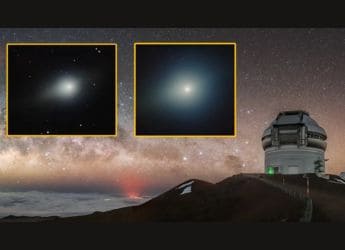- Home
- Science
- Science News
- James Webb Space Telescope 'Will Be Orbiting Lagrange Point 2': NASA Explains What It Means
James Webb Space Telescope 'Will Be Orbiting Lagrange Point 2': NASA Explains What It Means
Lagrange points refer to locations where the Earth’s gravitational pull completely balances out the Sun’s much stronger gravity

Photo Credit: NASA
An illustration of James Webb Space Telescope before its main mirror was unfolded
NASA's James Webb Space Telescope is set to orbit the Lagrange point 2 in relation to the Earth and the Sun. But, what does it really mean? Where is Lagrange point 2 located and why is it of note? Explaining the intricacies, the space agency recently tweeted about the orbit that the telescope will follow over the next few months. In the first tweet in a thread, NASA wrote, “So…you've heard that the Webb telescope will be orbiting Lagrange point 2. But what even is that, anyway? And how do you orbit something that isn't an object?"
The space agency clarified Lagrange point in a tweet thread. “Lagrange points refer to locations where the gravitational forces of 2 massive objects — such as the Sun and Earth — are in equilibrium,” NASA said.
In simpler terms, it's the point where the Earth's gravitational pull completely balances out the Sun's much stronger gravity. The James Webb telescope will be orbiting at Sun-Earth Lagrange point 2 (L2) for its mission.
So…you've heard that the Webb telescope will be orbiting Lagrange point 2. But what even is that, anyway? And how do you orbit something that isn't an object?
— NASA Webb Telescope (@NASAWebb) January 21, 2022
We've got you! Here's a thread ⬇️#UnfoldTheUniverse pic.twitter.com/7YTUeKh3Me
First, the basics. Lagrange points refer to locations where the gravitational forces of 2 massive objects — such as the Sun and Earth — are in equilibrium. Webb will be located more specifically at Sun-Earth Lagrange point 2, or L2 for short.
— NASA Webb Telescope (@NASAWebb) January 21, 2022
Researchers have plotted James Webb's orbit in such a way that the telescope's sunshield can always face all of these heat and light sources. This will protect James Webb's optics and instruments, which need to stay cold in order to "detect faint heat signals in the universe.”
Why send Webb to orbit L2?
— NASA Webb Telescope (@NASAWebb) January 21, 2022
???? Shade: The Sun, Earth (and Moon) are always on one side. At L2, Webb's sunshield can always face all of these heat & light sources to protect Webb's optics & instruments, which have to stay super cold to detect faint heat signals in the universe.
The telescope can cover a view of half the sky at any given moment. According to NASA, in six months, James Webb will be able to capture the entire sky.
???? Views: Webb can access nearly half the sky at any given moment, and the entire sky over the course of 6 months.
— NASA Webb Telescope (@NASAWebb) January 21, 2022
Watch this video to learn more: https://t.co/Q6naL7SGLZ
Instead of simply sitting at L2, James Webb is designed to orbit around that point. This is because it is a more efficient way in which the telescope will always have a continuous supply of solar energy for its thermal stability and power generation.
⛽️ Efficiency: Many of you have asked: Why doesn't Webb just sit at L2? It's actually simpler & more efficient for Webb to orbit L2!
— NASA Webb Telescope (@NASAWebb) January 21, 2022
⚡️ Power: This orbit also ensures that Webb will never have the Sun eclipsed by Earth — necessary for Webb's thermal stability & power generation.
Another reason for choosing the L2 point is that it is "convenient for always maintaining contact with our Mission Operations Center at Space Telescope Science Institute through the Deep Space Network," as per NASA. The James Webb telescope is not alone in its mission. Other observatories also orbit L2 for the same reasons.
???? Communication: L2 is convenient for always maintaining contact with our Mission Operations Center at @SpaceTelescope through the Deep Space Network. Webb isn't the first spacecraft to orbit L2, either! Other observatories like WMAP & Herschel also orbit L2 for these reasons.
— NASA Webb Telescope (@NASAWebb) January 21, 2022
James Webb's rocket has recently slowed down during the last lap of the launch. That's because scientists wanted the telescope to slow down and start orbiting at the desired location. Had it been given more power “Webb would have been going too fast when it got to L2, and we would overshoot our desired orbit”.
If the @Arianespace rocket had given Webb more energy than it had, Webb would have been going too fast when it got to L2, and we would overshoot our desired orbit. Webb can't brake or turn back, as it would both cost a lot of fuel and require Webb to expose its optics to the Sun.
— NASA Webb Telescope (@NASAWebb) January 21, 2022
The rocket engines aboard James Webb will give a thrust every three weeks to keep it stable in its orbit.
???? Webb's rocket gave it juuuust enough energy to be placed into its orbit — with a few course-correction burns along the way to make up the difference. Rocket engines aboard Webb will use thrust about every 3 weeks to keep it looping around L2 in a halo orbit every 6 months.
— NASA Webb Telescope (@NASAWebb) January 21, 2022
James Webb also had to undergo some course-correction burns along the way in order to find the right amount of energy for orbiting around L2.
Get your daily dose of tech news, reviews, and insights, in under 80 characters on Gadgets 360 Turbo. Connect with fellow tech lovers on our Forum. Follow us on X, Facebook, WhatsApp, Threads and Google News for instant updates. Catch all the action on our YouTube channel.
Related Stories
- Samsung Galaxy Unpacked 2025
- ChatGPT
- Redmi Note 14 Pro+
- iPhone 16
- Apple Vision Pro
- Oneplus 12
- OnePlus Nord CE 3 Lite 5G
- iPhone 13
- Xiaomi 14 Pro
- Oppo Find N3
- Tecno Spark Go (2023)
- Realme V30
- Best Phones Under 25000
- Samsung Galaxy S24 Series
- Cryptocurrency
- iQoo 12
- Samsung Galaxy S24 Ultra
- Giottus
- Samsung Galaxy Z Flip 5
- Apple 'Scary Fast'
- Housefull 5
- GoPro Hero 12 Black Review
- Invincible Season 2
- JioGlass
- HD Ready TV
- Laptop Under 50000
- Smartwatch Under 10000
- Latest Mobile Phones
- Compare Phones
- Redmi Note 15 5G
- Redmi Note 15 Pro 5G
- Redmi Note 15 Pro+ 5G
- Lava Play Max
- Poco C85 5G
- Honor Magic 8 Lite
- Jolla Phone
- Realme P4x 5G
- Asus ProArt P16
- MacBook Pro 14-inch (M5, 2025)
- OnePlus Pad Go 2
- Poco Pad M1
- Just Corseca Skywatch Pro
- Honor Watch X5
- Acerpure Nitro Z Series 100-inch QLED TV
- Samsung 43 Inch LED Ultra HD (4K) Smart TV (UA43UE81AFULXL)
- Asus ROG Ally
- Nintendo Switch Lite
- Haier 1.6 Ton 5 Star Inverter Split AC (HSU19G-MZAID5BN-INV)
- Haier 1.6 Ton 5 Star Inverter Split AC (HSU19G-MZAIM5BN-INV)

















